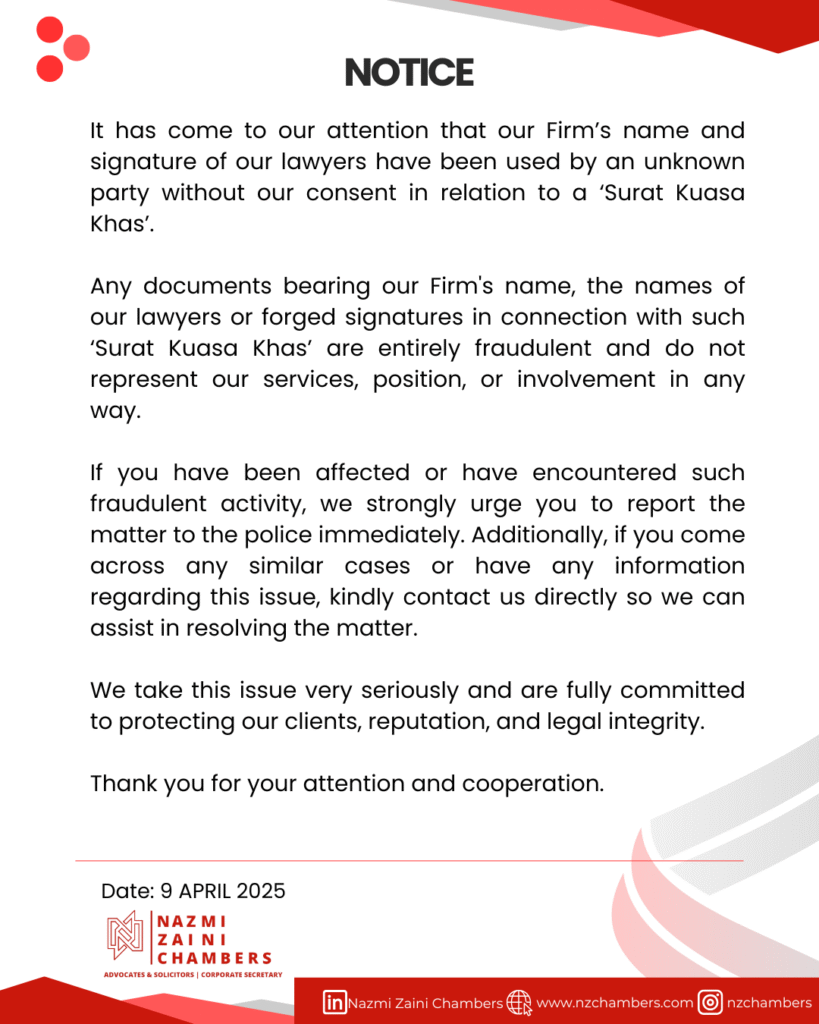A reduction of capital occurs where a company reduces the amount of its share capital. Under the Malaysia Companies Act 2016 (‘Act’), the Act provides two methods for companies to execute its scheme of capital reduction. This is an addition from the previous Companies Act 1965 wherein it only provides mechanism for capital reduction by way of confirmation before the Court. Section 115 of the Act stated that, the reduction of capital can be by way of confirmation of a special resolution at the High Court or a special resolution supported by a solvency statement.
In this article, we will discuss about the objectives of capital reduction, method of executing the scheme of capital reduction pursuant to the Act and further discuss the requirement of fairness and equity for the confirmation of the scheme at the High Court by referring to two English cases namely the case of Ex Parte Westburn Sugar Refineries Ltd [1951] AC 625 (‘Westburn’) and In Re Holders Investment Trust Ltd. [1971] 1 WLR 583 (‘Holders Investment Trust’).
The Objectives of Capital Reduction
Few objectives of a capital reduction are as follows:
To reduce liability, reduction of capital may reduce a company’s liability wherein the shares are reduced to a more manageable level according to the financial circumstances of a company;
To return surplus capital, when a company has a surplus capital, the company may no longer needed the shareholders which the shares issued will be canceled and payment will be made to them; and
To maintain the sustainability of dividend payments, capital reduction helps the company to manage the dividend payment to the shareholders wherein the payment can be more sustainable if the shares are reduced.
The Procedures of Capital Reduction Under the Act
Under the Companies Act, Section 115 provides two methods for companies to reduce its capital which are by way of: –
Section 116 of the Act: a special resolution and confirmation by the High Court in accordance; or
Section 117 of the Act: a special resolution supported by a solvency statement from all the directors of the company.[1]
We will discuss about the procedure via Solvency Statement which is provided under Section 117 of the Act wherein it is done by way of providing solvency statement to support the special resolution passed by the company. When the company is pursuing this mechanism, a special resolution shall be passed and met the solvency requirements as stated in Section 117(3)(b)(i) of Companies Act 2016. However, based on the Section 117(4), the company is not required to fulfill the solvency requirements if the reduction of share capital is solely by way of cancellation of any paid-up share capital which is at lost unrepresented by available assets[2].
The option to reduce the capital by way of Solvency Statement is seen as fast and easy method for the company. However, it is a double-edge sword procedure as pursuant to Section 117(3)(a) requires for all of the directors to provide a solvency statement in relation to the capital reduction which would expose the directors to liabilities if things went south. Hence, the company may opt for the scheme to be confirmed by the Court pursuant to Section 116 of the Act. The company may by special resolution reduce its capital by way of: –
a. extinguishing or reducing the liability on any of the shares of the company in respect of unpaid share capital;
b. cancelling any paid-up share capital which is lost or unrepresented by available assets; and
c. returning to the shareholders any paid-up share capital which in excess of the needs of the company.
If the company opt to pursue with a Court Order, few requirements under the law need to be fulfilled before the Court. This requirement also may be an issue before the Court in the event that any interested parties or creditors is disputing the scheme that has been executed by way of Solvency Statement. Next, we will discuss about the requirement of a fair and equitable capital reduction scheme[3].
The Requirement for a Fair and Equitable Scheme
For the Court to confirm the scheme, the company must satisfy the Court that the said scheme is fair, equitable and it did not prejudice the interest of the creditors, shareholders and the public. We will discuss about the case of Holders Investment Trust wherein the Court has dismissed the petition for confirmation of capital reduction proposal even though the said proposal was agreed by the majority shareholders of the company.
In that case, the minority shareholders disputed and opposed the proposal as the proposal is not done according to interest of a class of shareholders. The proposal for capital reduction in that case was structured by way of cancellation of 5 percent shares and substituting it by a 6 percent loan stocks. The shareholders were not satisfied with the proposed structure. The Court in dismissing the petition held that it is the burden of the company to show to the Court that the capital reduction is fair and for the benefit of a whole class of the shareholders and not just individual shareholders, even though it was agreed by majority shareholders. Mergarry J, in dismissing the petition held as follows: –
Mr. Instone disclaimed any contention that the scheme was generous to preference shareholders, and readily accepted that the company could have proposed a different scheme: but, he said, the question was not whether the scheme is the best scheme for the preference shareholders that could be put forward, but whether it was fair. That I accept. Nevertheless, in my judgment, the scheme seems to fall substantially below the threshold of anything that can justly be called fair. If, as I hold, the onus of showing fairness is on the company, that onus has not been discharged. If, contrary to my opinion, the onus is on the opposing trustees, in my judgment they have demonstrated that the scheme is unfair.[4]
Further, in the case of Westburn Sugar, the Court discussed about the requirements of fairness and interest of the public. This is a case before the House of Lords wherein the appeal was heard after the petition was dismissed by the Court of Session on the ground that it was against the public policy.[5] Lord Normand propounded that the Court will not be concerned with structure of the capital reduction but they will be concerned with the fairness and the interest of interested parties. Lord Normand held that: –
“The general rule is that the prescribed majority of the shareholders are entitled to decide whether there should be a reduction of capital, and, if so, in what manner and to what extent it should be carried into effect. When the reduction is consequent on a change in the method of carrying on the company’s business it is for the shareholders to decide to what extent its capital is in excess of its wants and on the adequacy of the consideration for the reduction of their share capital, but the powers of the shareholders must be exercised so as to safeguard the rights of creditors, the just and equitable treatment of shareholders, and the interest of the investing public”
The House of Lords allowed the appeal as the issue of contravening the public interest is seen as theoretical rather than practical. Hence, in ensuring a smooth operation of the scheme, company must ensure that the capital reduction is a fair scheme which will benefit the whole class of shareholders and not contravening the interest of the stakeholders such as creditors.
Conclusion
In conclusion, capital reduction is beneficial for the company especially during the phase of economic crisis during Covid-19 pandemic. However, the company must always be aware and diligent to ensure that the proposed scheme of capital reduction will adequately be beneficial to a whole class of shareholders, creditors and in compliance with the public interest to avoid any legal consequences.
Author: Fatihah Azhar
Published Date: 1 September 2022
References
1. Section 115 of the Companies Act 2016
2. Section 117(4) of the Companies Act 2016
3. Thuraisingham, S., Joshi, A., & Balan, S. (2021). Concise Principles of Malaysian Company Law. LexisNexis Malaysia Sdn Bhd.
4. Re Holders Investment Trust
5. Ex parte Westburn Sugar refineries ltd [1951] ac 625






